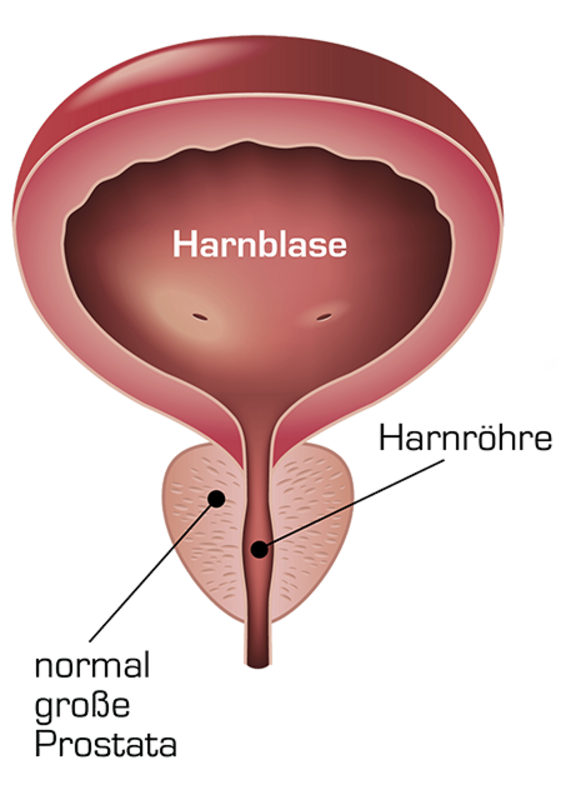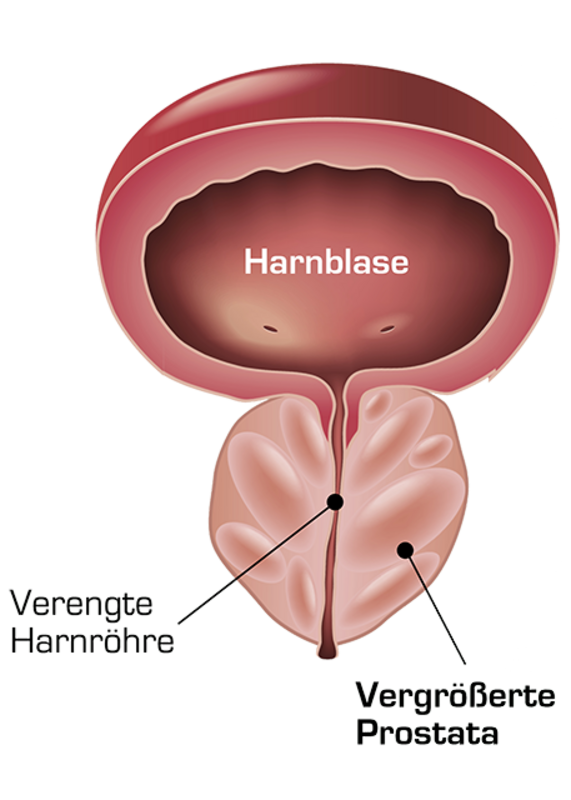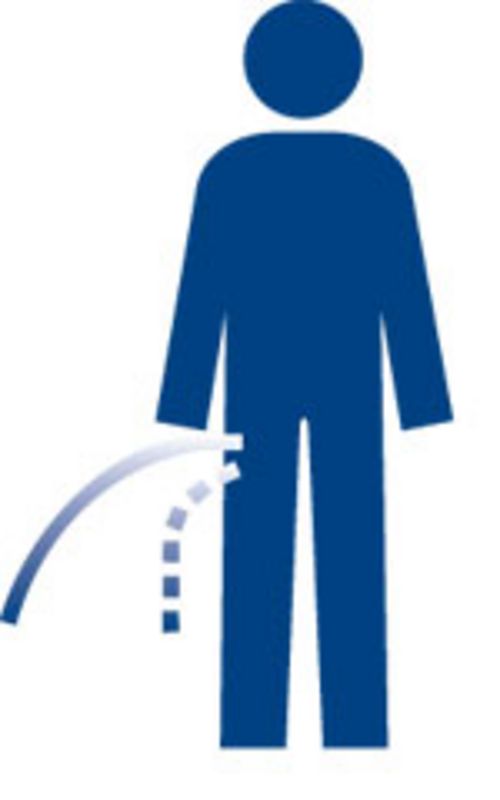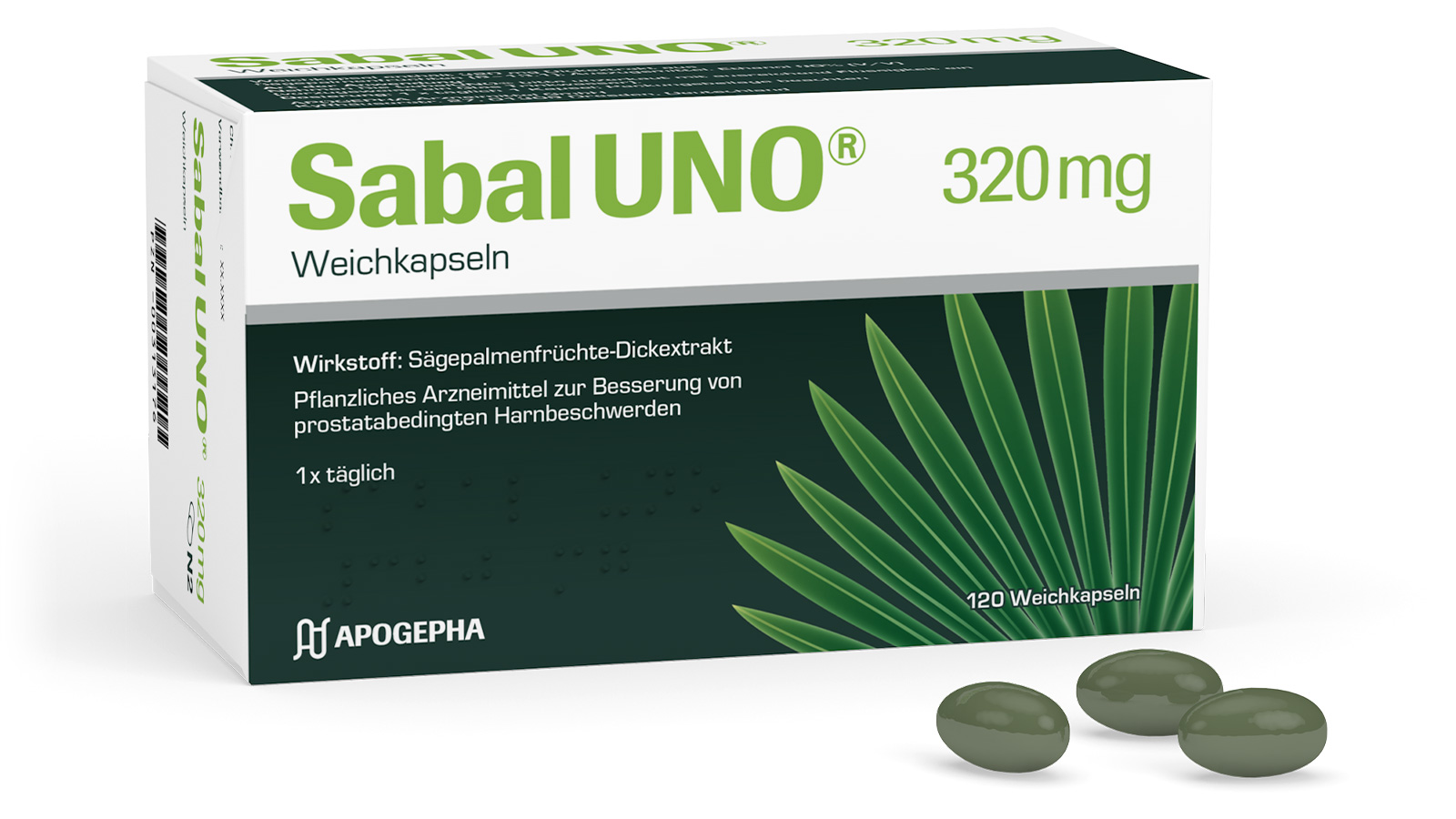Benign prostatic enlargement
The exact cause of prostatic enlargement is still unknown. However, we know that several factors influence the growth of the prostate.

Benign prostatic enlargement
The prostate (prostate gland) belongs to the male sex organs and resembles a chestnut in shape and size. It is located directly below the urinary bladder and surrounds the urethra.
The prostate consists of connective tissue, smooth muscles and many individual glands, which are stimulated by hormones to produce a secretion that is excreted together with sperm during ejaculation to ensure sperm motility.

In young men, the prostate weighs around 20 g, but in most men, it starts growing again around the age of 40. This growth is benign and is called benign prostatic hyperplasia (BPH), a medical term that describes the tissue changes. Benign prostatic hyperplasia eventually leads progressively to benign prostate enlargement (BPE).

BPE – benign, but not always without problems
The exact cause of prostatic enlargement is still unknown. However, we know that not only one single cause is responsible, but probably several at the same time. One of the main factors is the change in the hormonal balance, particularly the levels of testosterone and oestrogen, which occurs in the male organism with increasing age. Both hormones promote prostatic growth. In addition, inflammatory processes can be involved.
The continuous growth of the prostate gland can narrow the urethra to such an extent that urination can cause discomfort. Approximately every second man over the age of 50 is affected by BPH, of which about one third has clinical symptoms. In men above 70 years, about 80% have BPH and almost half of them have clinical symptoms. If BPE is detected early, treatment with medications can be carried out and might even postpone surgery.

When BPE causes noticeable symptoms, they are often referred to as “male LUTS/BPH”. This refers to the interrelation between benign prostate hyperplasia (BPH), the so caused benign prostatic enlargement (BPE) and the resulting difficulties in urination and the discomfort at the time of urination. The term ‘male LUTS’ (male lower urinary tract symptoms) encompasses all symptoms of the lower urinary tract in men.
Symptomatic BPE should be treated in order to relieve symptoms and, above all, to prevent possible secondary diseases (e.g. urinary retention, bladder/kidney infection, prostate inflammation or an overactive bladder).
Typical signs of BPE:
- frequent urination
- sudden urge to urinate
- nocturia (urination during night-time)
- weakened or even interrupted urine flow
- delayed urination
- incomplete bladder emptying
- post-void dribbling
Diagnosis of the different stages
The IPSS
As benign prostatic enlargement is constantly progressing, the symptoms worsen over time. Different strategies can be successful in the treatment of different stages of the disease. To assess the current stage, but also to evaluate the progression of prostatic enlargement, the doctor often uses a standardised questionnaire (IPSS = International Prostate Symptom Score). The score obtained by answering this questionnaire is an indication of the stage.
Besides the IPSS, further diagnostic methods include anamnesis, palpation or ultrasound.
You can use the IPSS questionnaire for initial orientation. Given that the same symptoms can often have very different causes, you should leave the medical evaluation of your IPS-score to your doctor.
Various treatment options for BPE symptoms
Depending on the symptoms, the therapy is adapted to the individual needs of each man.
In the case of mild symptoms, ‘watchful waiting’ is usually sufficient (0-7 points in the IPSS).
If the symptoms are more severe (8-19 points in the IPSS), phytotherapy (with herbal prostate medicines) or other medicinal therapy is often used. For medicinal treatment of benign prostatic enlargement and LUTS/BPH, alpha-receptor blockers (alpha-blockers) and 5-alpha-reductase inhibitors are available. Furthermore, combination therapies of alpha-1-blockers and 5-alpha-reductase inhibitors or alpha-1-blockers and muscarinic receptor antagonists can also be used. Increasingly, minimally invasive therapies are also being used to alleviate the symptoms of BPE und LUTS/BPH.
In the case of severe symptoms, interventional therapies must often be resorted to. These interventions include minimally invasive and surgical solutions.
Depending on the symptoms caused by the enlarged prostate, some treatment options are more suitable than others for the individual clinical picture. In general, however, early treatment is necessary to avoid further damage, especially to the urinary bladder.
Early diagnosis and therapy allow for uncomplicated treatment methods that can prevent or slow down the progression of symptoms. If the benign enlargement of the prostate is detected in time, treatment can be carried out with medications for years, making surgery unnecessary or at least postponing it.
Screen and react on changes
The size of the prostate increases slowly and hence the signs of BPE and LUTS/BPH occur slowly and are not associated with pain.
But even if the symptoms have become obvious, many men come to terms with them. However, not infrequently, this can lead to bladder damage or necessitate surgery because the oversized prostate might block urine flow completely (urinary retention). Therefore, regular annual screenings from the age of 45 are very important. It is painless and uncomplicated. The costs for this are usually covered by the health insurance once a year.
Pay attention to your body's warning signs and inform your doctor if you notice any of the following:
Warnings and indicators for prostatic enlargement and LUTS/BPH
- frequent urination
- sudden urge to urinate
- nocturia (urination during night-time)
- weakened or even interrupted urine flow
- delayed urination
- incomplete bladder emptying
- post-void dribbling
- burning sensation during urination due to inflammation of the urinary tract
Long-term prevention of bothering BPE and mLUTS/BPH – with diet and lifestyle
Being active can make a difference because the following practices have a positive effect on the prostate and micturition problems:
- Live a healthy and active life.
- Avoid prolonged sitting and getting too cold.
- Light physical exercise, e.g. walks, gardening, alleviate prostate problems.
- Make sure you eat a balanced diet.
- Drink approx. 1.5 to 2 litres of fluids per day, e.g., tea, mineral water, juice spritzers.
- Avoid excessive alcohol consumption, very cold drinks and strong coffee.
- Make sure you have regular bowel movements.
- Enjoy a fulfilling love life. It can have a positive effect on your prostate problems.
- Pay attention to the warning signs of your body. If the symptoms worsen, inform your doctor immediately.
APOGEPHA products against symptoms of prostate enlargement

Sabal UNO®
Pflanzliches Prostatamittel, Kapsel mit 320 mg Sägepalmenfrüchte-Extrakt